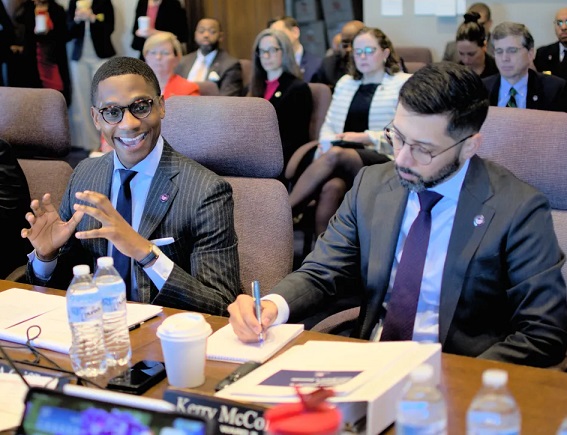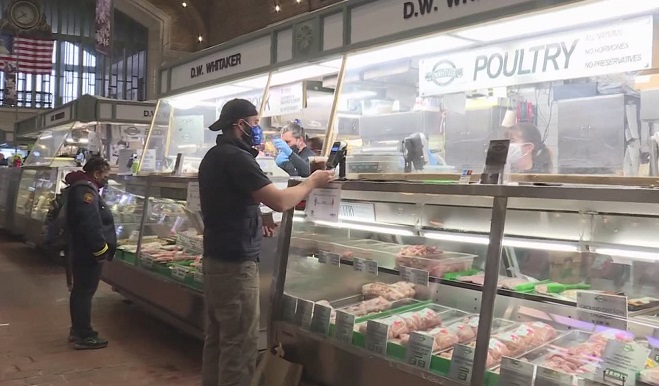Cleveland Settles On $10 Million For West Side Market Renovations, But Is It Enough?
FEATURED PHOTO: CLEVELAND COUNCIL PRESIDENT BLAINE GRIFFIN

IdeastreamPublicMedia.org, By Abbey Marshall, Posted May 23rd 2023
The West Side Market is going to get $10 million to fund infrastructure improvements – but that’s half the amount proposed by Mayor Justin Bibb, and only a third of what the city says the market actually needs.
The decision seems to be the end of the battle between Cleveland City Council and the mayor over how much of the city’s federal stimulus money would go toward the aging, city-owned market.
Bibb’s original $20 million proposal was met with opposition from many council members, who insisted the money would be better spent in the city’s middle- to low-income neighborhoods. The money is coming from the city’s half-billion dollar pot of American Rescue Plan Act funds, which is intended to invest in communities most affected by the COVID-19 pandemic.
“We often use poor BIPOC [Black, Indigenous, and People of Color] communities that justify cities getting the dollars, but then those same poor BIPOC communities are often the last to get any investments, get any support,” said City Council President Blaine Griffin in Monday’s finance committee meeting.
But as the building ages, the roof continues to leak and elevator outages shutter operations for vendors, Bibb and the market’s tenants argue that the time to invest is now, or the city’s century-old public market faces a bleak future.
“Lack of political will and funding has allowed it to fall into disrepair,” a spokesperson for the Bibb administration said Wednesday. “City Council’s failure to approve the administration’s $15 million ARPA proposal for basic capital repairs puts the market at risk.”
The last of the West Side Market’s four freight elevators gave out on Wednesday, stranding vendors who needed to move their goods to stalls upstairs.

City isn’t being a good landlord, business owners say
In his State of the City address last month, Bibb doubled down on his commitment to take negligent property owners to task for unkempt properties. His administration argues that as the owner of the West Side Market, the city is responsible for the backfill of infrastructure failures that have been maintained with a series of “band-aid fixes.”
“Just as the city wants to hold every other property owner responsible for the properties they own, we are the responsible property owner for the West Side Market,” said Jessica Trivisonno, the senior strategist for the West Side Market.
The market’s infrastructure repairs are estimated at about $33 million, more than three times the amount city council approved to spend on Monday night. Market vendor Don Whitaker said “council got off pretty easy.”
“I pay my rent, you expect certain things from your landlord,” said Whitaker, who owns DW Whitaker Meats and also heads the market’s tenant organization.
A sign sits in a display case at a West Side Market stall that closed last month due to elevator failures.
Whitaker, among other West Side Market vendors, is frustrated by the political volley between the mayor and city council. He said his business and others will suffer as a result.
“They blame the administration, the administration blames council,” Whitaker said. “It’s just this back and forth battle that’s been going on forever and at the end of the day, the vendors are the ones who have to work in the building.”
City council members argue they have already poured millions into the market. Between 2019 and 2022, the city put $10.5 million toward the market as part of a citywide $40.5 million investment in facility repairs, Griffin said.

The ‘slow decline’ and uncertain future of the market
Whitaker said vendors are “disappointed” by the $10 million commitment, while the city will have to scramble to close the gap through private and philanthropic efforts.
Those fixes are part of a $45 million master plan laid out by the city as a nonprofit prepares to take over management responsibilities for the market, which includes a vision for a prepared food hall and other major improvements.
The nonprofit said those upgrades could bring in revenue in the future, including plans for events, fundraising and sponsorships. But without investment toward those revenue streams, Trivisonno said the market will continue to hemorrhage money on what she called an “expensive, slow decline.”
Ideastream Public Media
West Side Market’s indoor hall is 22% vacant.
The market has operated at a loss since 2015, and its budget has been subsidized with hundreds of thousands of dollars from the city’s general fund.
As it now stands, the produce hall is 50% vacant and the inside market hall is 22% vacant. Trivisonno said those vacancies and cost to the city will continue to grow if they don’t use ARPA to “get ahead of it.”
The newly-created Cleveland Public Market Corporation will implement the master plan once it takes over management duties, but the city will still remain the owner of the building with the expectation of making some capital improvements.
The nonprofit’s vision of a local and tourist destination like Findlay Market in Cincinnati or Pike Place in Seattle, now seems further off, or not at all likely without more investment, its representatives said.
“Without that, I don’t see this going forward,” said Dave Abbott, the chair of the Cleveland Public Market Corporation. “I don’t think there’s a possibility of a nonprofit taking on this responsibility because the demands exceed our capacity.”

